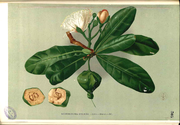| Barringtonia asiatica | |
|---|---|

| |
| Conservation status | |
 Least Concern (IUCN 3.1) | |
| Scientific classification | |
| Kingdom: | Plantae |
| Clade: | Tracheophytes |
| Clade: | Angiosperms |
| Clade: | Eudicots |
| Clade: | Asterids |
| Order: | Ericales |
| Family: | Lecythidaceae |
| Genus: | Barringtonia |
| Species: | B. asiatica |
| Binomial name | |
| Barringtonia asiatica (L.) Kurz | |
| Synonyms | |
13 synonyms
| |
Barringtonia asiatica, also known as fish poison tree, putat or sea poison tree, is a species of Barringtonia native to mangrove habitats from islands of the Indian Ocean in the west to tropical Asia and islands of the western Pacific Ocean.
Description
It is a small to medium-sized tree growing to 7–25 m tall. The leaves are narrow obovate, 20–40 cm in length and 10–20 cm in width. Fruit produced as mentioned earlier, is otherwise aptly known as the Box Fruit, due to distinct square like diagonals jutting out from the cross section of the fruit, given its semi spherical shape form from stem altering to a subpyramidal shape at its base. The fruit measures 9–11 cm in diameter, where a thick spongy fibrous layer covers the 4–5 cm diameter seed.
Taxonomy
This species was first described in 1753 as Mammea asiatica by Carl Linnaeus, based on material collected from Java by Pehr Osbeck, a Swedish naturalist and one of Linnaeus' apostles. It was transferred to the genus Barringtonia by the German botanist Wilhelm Sulpiz Kurz in 1875. A number of other botanists have collected specimens of this plant and described them under different names, all of which are now recognised as synonyms (see synonyms list).
Etymology
The genus name was created to honour the English lawyer, antiquary and naturalist, Daines Barrington, while the species epithet asiatica refers to the region where this species is found.
Ecology
The fruit is dispersed in the same way as a coconut – by ocean current – and is extremely water-resistant and buoyant. It can survive afloat for up to fifteen years; it was one of the first plants to colonise Anak Krakatau when this island first appeared after the Krakatau eruption. When washed ashore, and soaked by rainwater, the seeds germinate.
Human use
All parts of the tree are poisonous, the active poisons including saponins. Box fruits are potent enough to be used as a fish poison. The seeds are ground to a powder and used to stun or kill fish for easy capture, suffocating the fish while the flesh is unaffected.
Gallery
-
 Illustration from Flora de Filipinas by Francisco Manuel Blanco
Illustration from Flora de Filipinas by Francisco Manuel Blanco
-
 Immature fruit (about fist size)
Immature fruit (about fist size)
-
 Flower
Flower
References
- Razafiniary, V. (2021). "Barringtonia asiatica". IUCN Red List of Threatened Species. 2021: e.T31339A166509744. doi:10.2305/IUCN.UK.2021-1.RLTS.T31339A166509744.en. Retrieved 19 November 2021.
- ^ "Barringtonia asiatica (L.) Kurz". Plants of the World Online. Royal Botanic Gardens, Kew. 2024. Retrieved 27 June 2024.
- ^ "Barringtonia asiatica Kurz". World Flora Online. World Flora Online Consortium. 2024. Retrieved 27 June 2024.
- ^ Ria Tan (2001). "Sea Poison Tree". Mangrove and wetland wildlife at Sungei Buloh Nature Park. Singapore. Archived from the original on December 2, 2011. Retrieved August 23, 2016.
- "Barringtonia asiatica". Germplasm Resources Information Network. Agricultural Research Service, United States Department of Agriculture. Retrieved November 1, 2011.
- "Barringtonia asiatica (Linnaeus) Kurz". Flora of China (eFloras). Missouri Botanical Garden, St. Louis, MO & Harvard University Herbaria, Cambridge, MA. Retrieved 27 June 2024.
- Linneaus, Carl (1753). Species plantarum. Stockholm. pp. 512–513. Retrieved 27 June 2024.
- "Name - Mammea asiatica L." Tropicos. Saint Louis, Missouri: Missouri Botanical Garden. Retrieved November 1, 2011.
- Kurz, Wilhelm Sulpiz (1873). "Appendix B. General key to the Burmese trees". Preliminary report on the forest and other vegetation of Pegu. Kolkata: C.B. Lewis, Baptist Mission Press. p. 52. doi:10.5962/bhl.title.25981.
- Forster, Johann Reinhold; Forster, Georg (1776). Characteres generum plantarum, quas in itinere ad insulas maris Australis, : collegerunt, descripserunt, delinearunt, annis (in Latin). London. p. 76. Retrieved 26 June 2024.
- Henderson, R.J.F.; Telford, I.R.H.; Kodela, P.G. (2022). Kodela, P.G. (ed.). "Barringtonia asiatica". Flora of Australia. Australian Biological Resources Study, Department of Climate Change, Energy, the Environment and Water: Canberra. Retrieved 27 June 2024.
- Tsou, C-H., and Mori, S.A. "Seed coat anatomy and its relationship to seed dispersal in subfamily Lecythidoideae of the Lecythidaceae (The Brazil Nut Family)." Botanical Bulletin of Academia Sinica. Vol. 43, 37-56. 2002. Accessed 2009-05-31.
- Thiel, M.; Gutow, L. (2004). "The ecology of rafting in the marine environment. I: The floating substrata". Oceanography and Marine Biology. 42: 181–264. Retrieved 27 June 2024.
- Thaman, R.R. "Receptors Batiri kei Baravi: The ethnobotany of the Pacific island coastal plants Archived September 19, 2009, at the Wayback Machine." Atoll Research Bulletin. Vol. 361, 1-62. May, 1992. Accessed 2009-05-31.
| Taxon identifiers | |
|---|---|
| Barringtonia asiatica |
|
| Mammea asiatica | |
- IUCN Red List least concern species
- Barringtonia
- Flora of tropical Asia
- Flora of the Pacific
- Flora of the Western Indian Ocean
- Trees of Taiwan
- Flora of the Zanzibar Archipelago
- Flora of Queensland
- Ericales of Australia
- Plants described in 1753
- Taxa named by Carl Linnaeus
- Flora of the Northern Territory
- Taxa named by Wilhelm Sulpiz Kurz